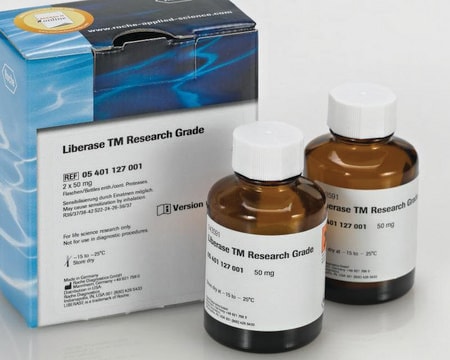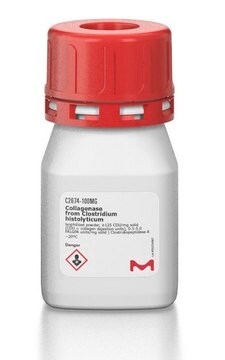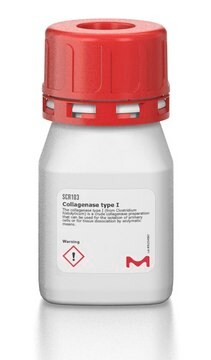Alle Fotos(2)
Wichtige Dokumente
C8176
Collagenase aus Clostridium histolyticum
Sigma Blend Type L, ≤1.0 FALGPA units/mg solid
Synonym(e):
Clostridiopeptidase A
Anmeldenzur Ansicht organisationsspezifischer und vertraglich vereinbarter Preise
Alle Fotos(2)
About This Item
Empfohlene Produkte
Qualitätsniveau
Form
powder
caseinase activity
≥40 units/mg solid
Spezifische Aktivität
≤1.0 FALGPA units/mg solid
Mol-Gew.
68-130 kDa
Lagertemp.
−20°C
Suchen Sie nach ähnlichen Produkten? Aufrufen Leitfaden zum Produktvergleich
Verwandte Kategorien
Anwendung
Collagenase from Clostridium histolyticum, or Clostridiopeptidase A, has been used in a study to assess the synthesis and in vitro evaluation of macromolecular antitumour derivatives based on phenylenediamine mustard. Clostridiopeptidase A has also been used in a study to investigate the enzymatic debridement of burn wounds with collagenase.
Biochem./physiol. Wirkung
Effective release of cells from tissue requires the action of collagenase enzymes and the neutral protease. Collagenase is activated by four gram atom calcium (Ca2+) per mole enzyme. The culture filtrate is thought to contain at least 7 different proteases ranging in molecular weight from 68-130 kDa. The pH optimum is 6.3-8.8. The enzyme is typically used to digest the connective components in tissue samples to liberate individual cells. Ethylene glycol-bis(β-aminoethyl ether)-N,N,N′,N′-tetraacetic acid (EGTA)4; β-mercaptoethanol; glutathione, reduced; thioglycolic acid, sodium; and 2,2′-dipyridyl; 8-hydroxyquinoline are known to inhibit the enzyme activity.
Collagenase wird durch vier Grammatom Calcium pro Mol Enzym aktiviert. Sie wird durch Ethylenglycol-bis-(beta-aminoethylether)-N, N, N′,N′-tetraessigsäure, β-Mercaptoethanol, Glutathion, Thioglycolsäure und 8-Hydroxychinolin gehemmt.
Einheitendefinition
Eine Collagen-Aufschlusseinheit (Collagen Digestion Unit, CDU) setzt Peptide aus Rinder-Achillessehnencollagen entsprechend der Ninhydrin-Anfärbung von 1,0 μmol Leucin in 5 Stunden bei pH 7,4 und 37 °C in Gegenwart von Calciumionen frei. Eine FALGPA-Hydrolyseeinheit hydrolysiert 1,0 μmol Furylacryloyl-Leu-Gly-Pro-Ala pro Minute bei 25 °C. Eine neutrale Protease-Einheit hydrolysiert die Caseinmenge, die eine Färbung entsprechend 1,0 μmol Tyrosin pro 5 Stunden bei pH 7,5 und 37 °C produziert. Eine Clostripain-Einheit hydrolysiert 1,0 μmol BAEE pro Minute bei pH 7,6 und 25 °C in Gegenwart von DTT.
Signalwort
Danger
H-Sätze
P-Sätze
Gefahreneinstufungen
Resp. Sens. 1
Lagerklassenschlüssel
11 - Combustible Solids
WGK
WGK 1
Flammpunkt (°F)
Not applicable
Flammpunkt (°C)
Not applicable
Persönliche Schutzausrüstung
dust mask type N95 (US), Eyeshields, Faceshields, Gloves
Hier finden Sie alle aktuellen Versionen:
Besitzen Sie dieses Produkt bereits?
In der Dokumentenbibliothek finden Sie die Dokumentation zu den Produkten, die Sie kürzlich erworben haben.
Kunden haben sich ebenfalls angesehen
Coşkun Ozcan et al.
Burns : journal of the International Society for Burn Injuries, 28(8), 791-794 (2002-12-05)
Seventy-eight pediatric burn patients treated by enzymatic debridement with collagenase clostridiopeptidase A (CCA), were compared to 41 patients those burn wounds were excised surgically. Patients whose burn wounds were initially assessed as partial-thickness at admission were enrolled in the study.
N I Solov'eva et al.
Bioorganicheskaia khimiia, 20(3), 303-309 (1994-03-01)
Interactions of collagenases I and II (clostridiopeptidases) from Clostridium histolyticum with hexapeptide substrates in which some L-proline residues are replaced by their D-analogues, as well as with the tripeptide chloromethyl ketone Z-Gly-Pro-Gly-CH2Cl were studied. A role of stereochemistry of the
Ruth M Williams et al.
STAR protocols, 2(2), 100414-100414 (2021-04-20)
In order to process samples by fluorescence-activated cell sorting (FACS), it is essential to obtain a single-cell suspension of dissociated cells. Numerous protocols and commercial reagents are available; however, each requires optimization for specific tissue types. Here, we describe an
Dag K Skovseth et al.
Methods in molecular biology (Clifton, N.J.), 360, 253-268 (2006-12-19)
The future ability to manipulate the growth of new blood vessels (angiogenesis) holds great promise for treating ischemic disease and cancer. Several models of human in vivo angiogenesis have been described, but they seem to depend on transgenic support and
Katleen De Winne et al.
European journal of pharmaceutical sciences : official journal of the European Federation for Pharmaceutical Sciences, 24(2-3), 159-168 (2005-01-22)
Poly-[N-(2-hydroxyethyl)-L-glutamine] (PHEG) and poly(ethylene glycol) (PEG)-grafted PHEG conjugates of N,N-di(2-chloroethyl)-4-phenylenediamine mustard (PDM) were synthetised. A collagenase-sensitive oligopeptide spacer was selected to link the cytotoxic agent PDM onto the polymeric carrier. First, the oligopeptide-drug conjugate, L-pro-L-leu-gly-L-pro-gly-PDM, was prepared. In a second
Unser Team von Wissenschaftlern verfügt über Erfahrung in allen Forschungsbereichen einschließlich Life Science, Materialwissenschaften, chemischer Synthese, Chromatographie, Analytik und vielen mehr..
Setzen Sie sich mit dem technischen Dienst in Verbindung.







